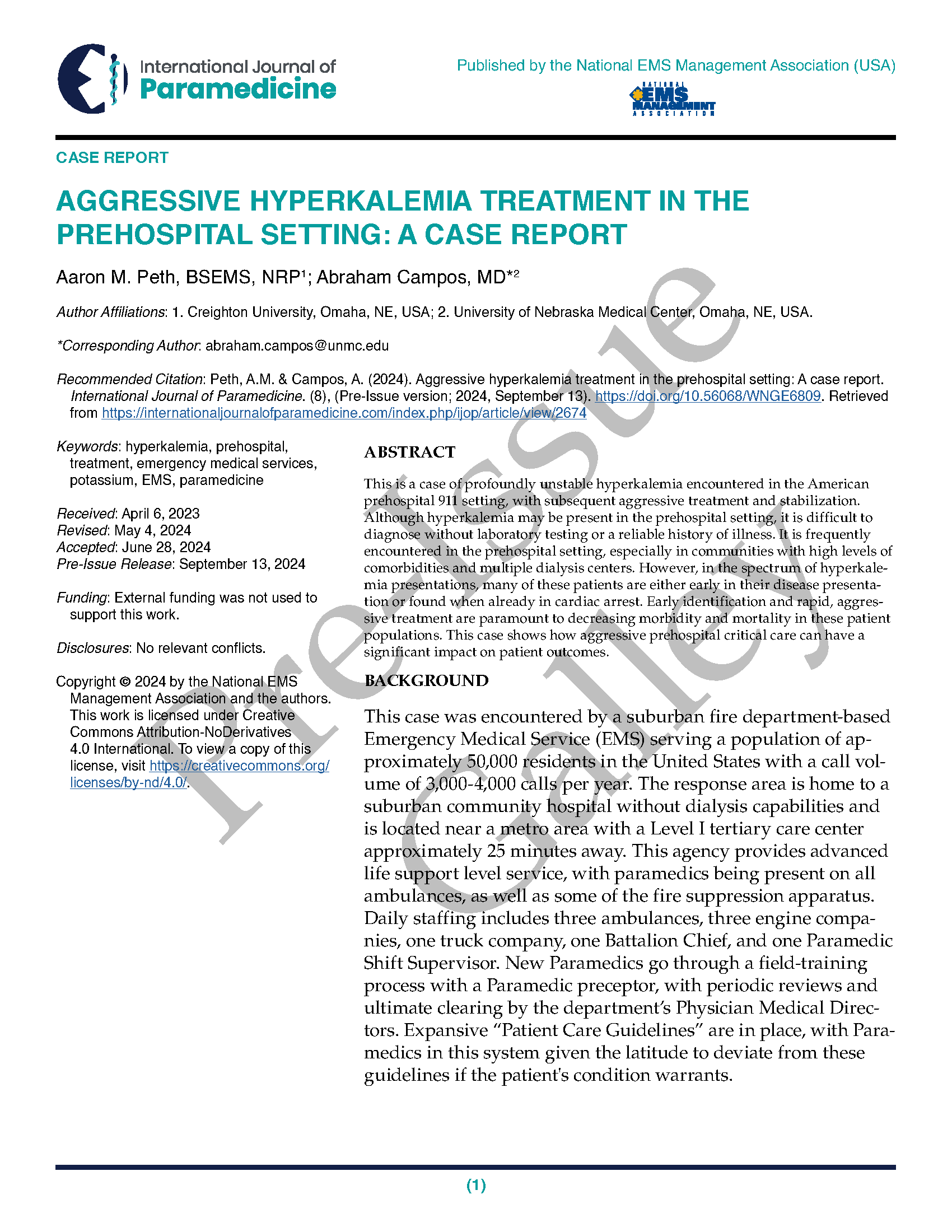Aggressive Hyperkalemia Treatment in the Prehospital Setting A Case Report
Main Article Content
Abstract
This is a case of profound unstable hyperkalemia encountered in the American pre-hospital 911 setting, with subsequent aggressive treatment and stabilization. Although hyperkalemia may be present in the prehospital setting, it is difficult to diagnose without laboratory testing or a reliable history of illness. It is frequently encountered in the pre-hospital setting, especially in communities with high levels of comorbidities and multiple dialysis centers. However, in the spectrum of hyperkalemia presentations, many of these patients are either early in their disease presentation or found when already in cardiac arrest. Early identification and rapid, aggressive treatment are paramount to decreasing morbidity and mortality in these patient populations. This case shows how aggressive prehospital critical care can have a significant impact on patient outcomes.
Article Details

This work is licensed under a Creative Commons Attribution-NoDerivatives 4.0 International License.
Publishing in IJOP allows authors to keep their copyright while giving IJOP unrestricted copyright permissions. Articles published in IJOP use Creative Common Attribution 4.0 International (CC BY-ND 4.0) licensing. This license requires that re-users give credit to the creator. It allows re-users to copy and distribute the material in any medium or format in unadapted form only, even for commercial purposes. Additional terms apply and can be accessed here.
Publishing in IJOP also allows authors to have contracts for non-exclusive distribution of the Journal's published version of the article, such as posting to an institutional repository or publication in a book, on the condition that the original publication in the original layout format in IJOP is retained and acknowledged.
We permit and encourage authors to post the articles they published in IJOP on their affiliated websites. This helps share the information, encourages citation in other works, and promotes scholarly discourse in the spirit of open access.
References
Berend, K., de Vries, A. P. J., & Gans, R. O. B. (2014). Physiological approach to assessment of acid–base disturbances. New England Journal of Medicine, 371(15), 1434–1445. https://doi.org/10.1056/nejmra1003327
Choi, D. S., Shin, S. D., Ro, Y. S., & LEE, K. W. (2020). Relationship between serum potassium level and survival outcome in out-of-hospital cardiac arrest using captures database of Korea: Does hypokalemia have good neurological outcomes in out-of-hospital cardiac arrest? Advances in Clinical and Experimental Medicine, 29(6), 727–734. https://doi.org/10.17219/acem/122178
Grunau, B., Kime, N., Leroux, B., Rea, T., Van Belle, G., Menegazzi, J. J., Kudenchuk, P. J., Vaillancourt, C., Morrison, L. J., Elmer, J., Zive, D. M., Le, N. M., Austin, M., Richmond, N. J., Herren, H., & Christenson, J. (2020). Association of intra-arrest transport vs continued on-scene resuscitation with survival to hospital discharge among patients with out-of-hospital cardiac arrest. JAMA, 324(11), 1058. https://doi.org/10.1001/jama.2020.14185
Jung, B., Martinez, M., Claessens, Y.-E., Darmon, M., Klouche, K., Lautrette, A., Levraut, J., Maury, E., Oberlin, M., Terzi, N., Viglino, D., Yordanov, Y., Claret, P.-G., & Bigé, N. (2019). Diagnosis and management of metabolic acidosis: Guidelines from a French expert panel. Annals of Intensive Care, 9(1). https://doi.org/10.1186/s13613-019-0563-2
Kovesdy, C. P. (2016). Epidemiology of Hyperkalemia: An update. Kidney International Supplements, 6(1), 3–6. https://doi.org/10.1016/j.kisu.2016.01.002
Montford, J. R., & Linas, S. (2017). How dangerous is hyperkalemia? Journal of the American Society of Nephrology, 28(11), 3155–3165. https://doi.org/10.1681/asn.2016121344

